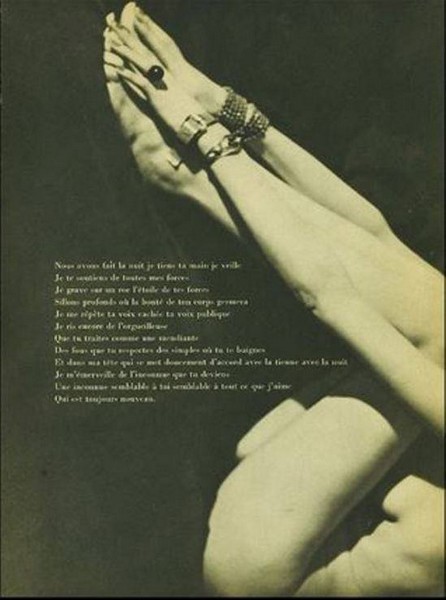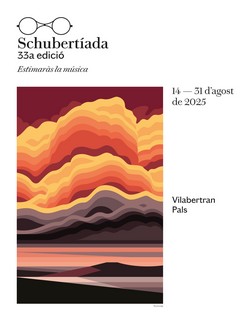
"A cycle that can be compared to the great German Lieder cycles, such as Schubert's Winterreise or Schumann's Dichterliebe." This is what Alexis Roland-Manuel said about Tel jour telle nuit (Such a day such a night). I don't really like the comparisons between non-homogeneous things (cycles in different languages, poems and songs written 100 years later), but there's little doubt that Francis Poulenc's cycle is great and has elements in common with those mentioned by the musicologist.
Poulenc wrote Tel jour telle nuit between December 1936 and January 1937, when he composed the last song; he premiered it along with baritone Pierre Bernac just some days after, on February 3rd. It was the second time that he had musicalized some verses of his friend Paul Éluard, after composing Cinq poèmes de Paul Éluard the previous year; he wrote three more cycles with his poems (the last of which, Le travail du peintre), but experts agree that Tel jour telle nuit is the greatest expression of their musical relationship.
Last week I talked about a Brahms' Lied included in a collection that, in some way, could be considered a cycle; it's hard to define what a cycle is. However, Tel jour telle nuit is a textbook example: all nine poems are from the same poet (eight of them from the same collection, Les yeux fertiles, from 1936) and the composer also linked musically the mélodies. He didn't want them to be performed isolated because they lose their sense: The value of each one depends on its place in the whole, the mélodie that precedes it and the one that follows it. In fact, some of them are just transitions, thought to prepare the path to the next one (Poulenc used to call them "springboard songs").
Of course, we'll ignore Poulenc and we'll listen to just one of the songs, as we always do; I'm aware that it's unnatural and I hope that after listening to that single song you'll feel like listening to the whole cycle. I hesitated between two of the songs and, finally, I chose Nous avons fait la nuit, considered by Poulenc one of his best mélodies and by scholars, one of the best French love songs of love. I hope that, once heard you will agree that it's a beautiful and special work, as the composer tells us: "I have written this mélodie with the most sincere emotion. I hope this is perceived." It's a calm, serene, intimate song and at the same time, as Poulenc says, emotional and intense: "It is difficult to convince the performers that in a love poem, calm can only result into intensity". There are songs whose strength lies in its calmness, although it seems a contradiction.
Nous avons fait la nuit is the ninth song of Tel jour telle nuit; the night closes a cycle that begins with the day, with Bonne journée (hence the title chosen by Éluard) and Poulenc musically relates them by using the same tonality. In addition, he uses something that Beethoven had already used in An die ferne Geliebte or Schumann in Dichterliebe or Frauenliebe und -leben: he closes the cycle with a postlude that gets back to the music of the first song, thus reinforcing the concept of cycle; as I told you at the beginning, that's a clear relationship between this work and the great cycles of the nineteenth century. I have always understood these postludes (that of Dichterliebe, for example) as an opportunity to gradually return to the real world, a few seconds before saying goodbye to the emotion created by music. That's why I really liked reading what Poulenc had written about his postlude: "it allows the listener to prolong the feelings generated by poems."
Éluard's poem transmits a deep love, admiration, and so much tenderness... As in the rest of Facile, the collection from where it's extracted, his words are inspired by Nusch, his wife. If you are a photography lover, perhaps her name sounds familiar to you, because Ray Man and Dora Maar often photographed her. She was a beautiful woman, and I could have chosen any of these portraits to illustrate this post (as I could have chosen also Picasso's portrait), but this song, or rather, this poem, has its own picture. Éluard wanted to illustrate the first edition of Facile with photographs of Nusch and he asked Ray Man to take a picture for every poem; the one heading this post is the one corresponding to Nous avons fait la nuit.
Please listen to this wonderful song performed by Felicity Lott and Graham Johnson.
Je te soutiens de toutes mes forces
Je grave sur un roc l’étoile de tes forces
Sillons profonds où la bonté de ton corps germera
Je me répète ta voix cachée ta voix publique
Je ris encore de l’orgueilleuse
Que tu traites comme une mendiante
Des fous que tu respectes des simples où tu te baignes
Et dans ma tête qui se met doucement d’accord avec la tienne avec la nuit
Je m’émerveille de l’inconnue que tu deviens
Une inconnue semblable à toi semblable à tout ce que j’aime
Qui est toujours nouveau.
I sustain you with all my strength
I engrave on a rock the star of your strength
deep furrows where the goodness of your body will germinate
I repeat to myself your secret voice your public voice
I laugh still at the haughty woman
whom you treat like a beggar
at the fools whom you respect the simple folk in whom you immerse yourself
and in my head which gently begins to harmonize with yours with the night
I marvel at the stranger that you become
a stranger resembling you resembling all that I love
which is ever new.














Comments powered by CComment